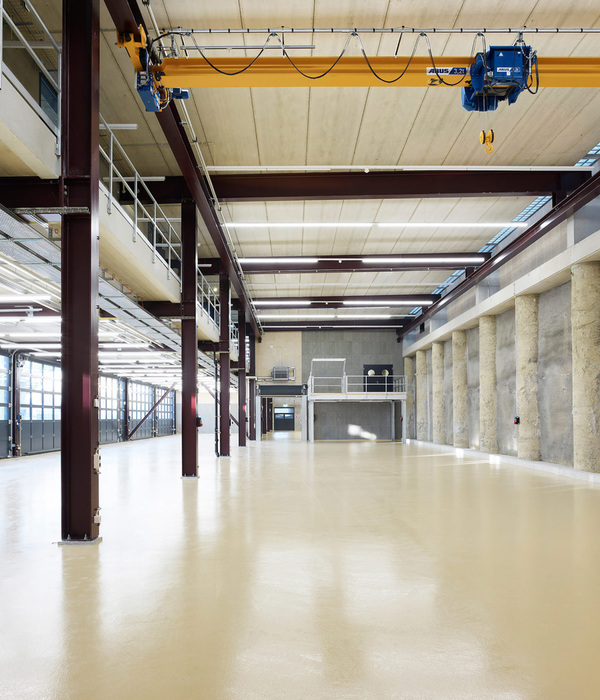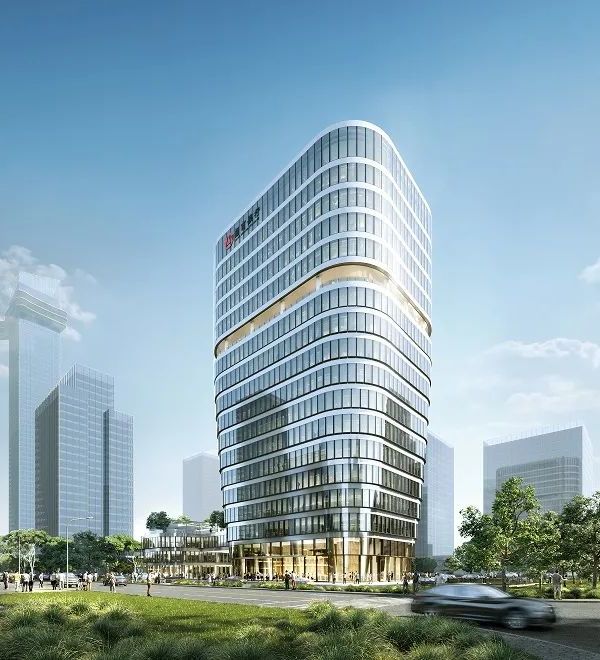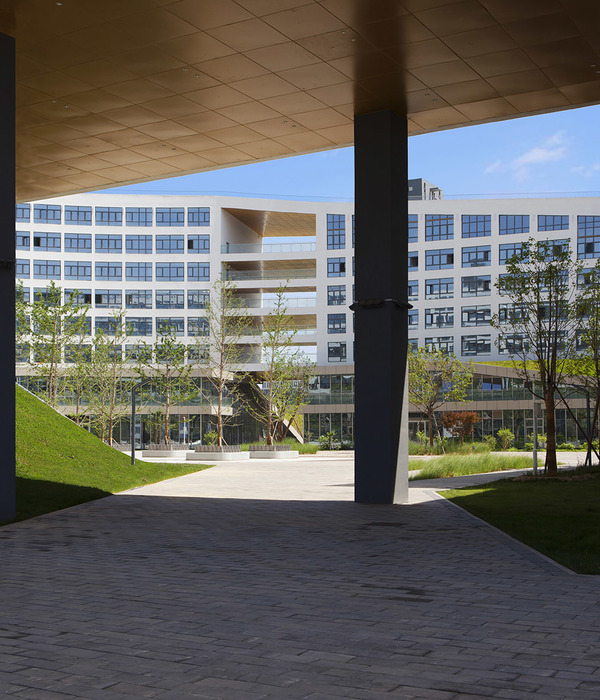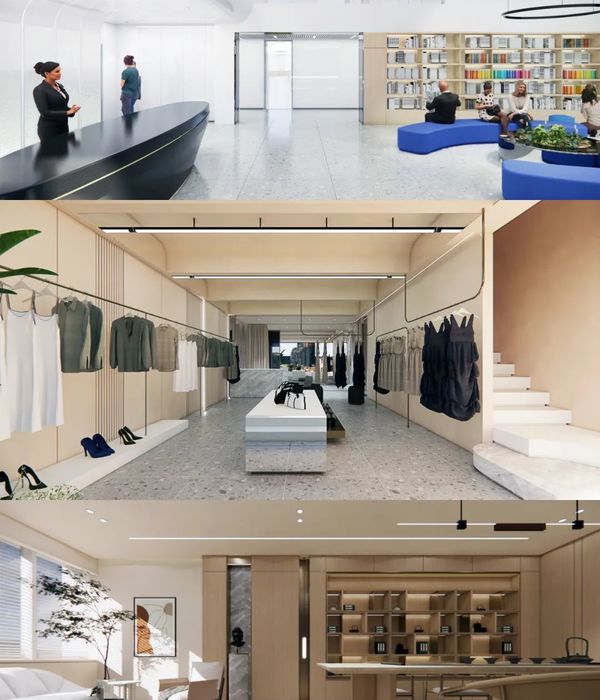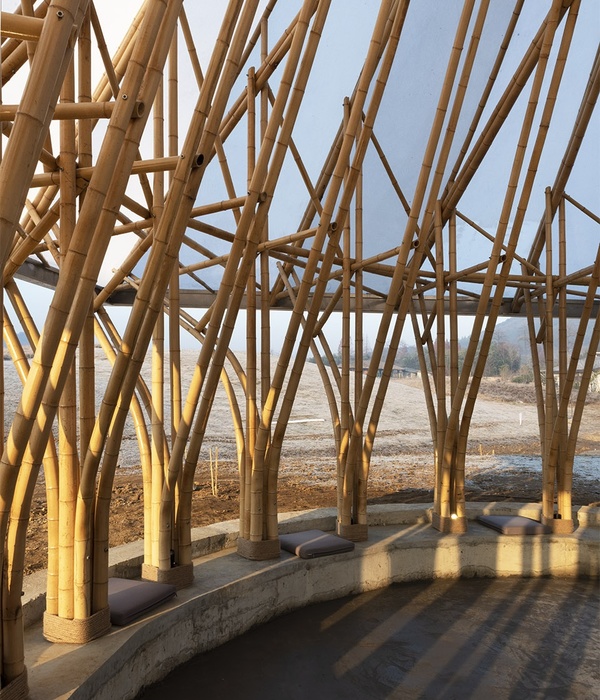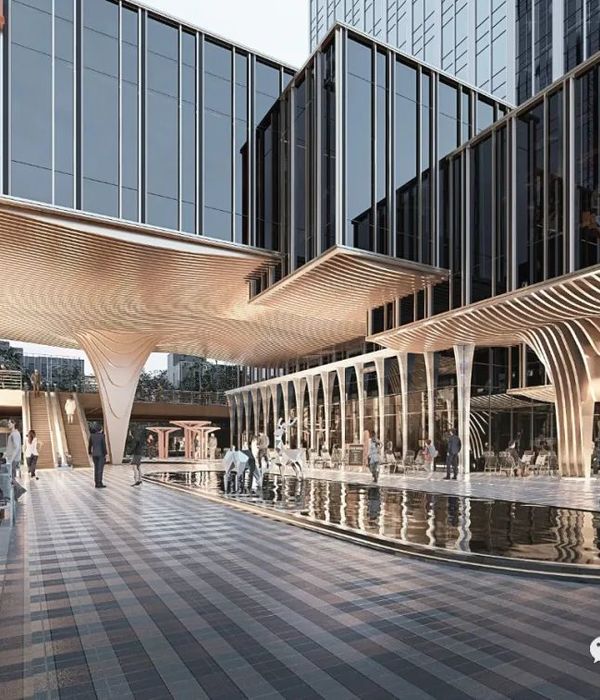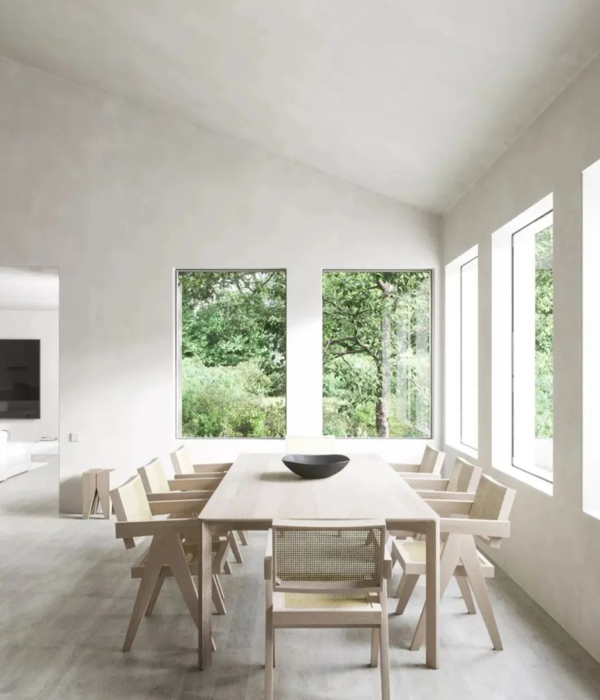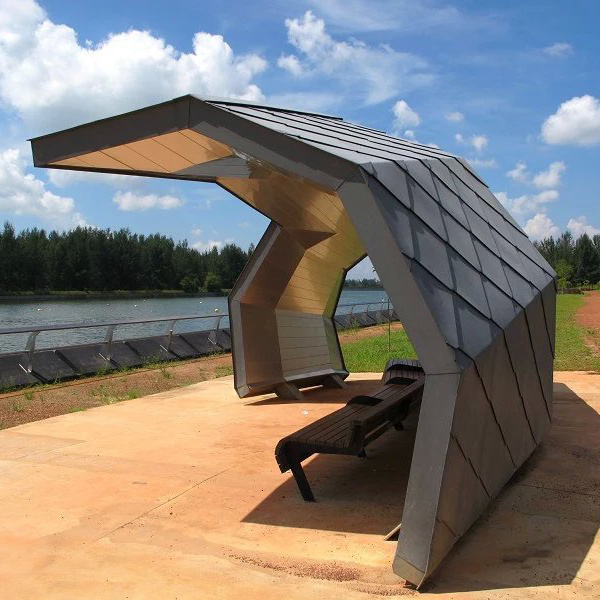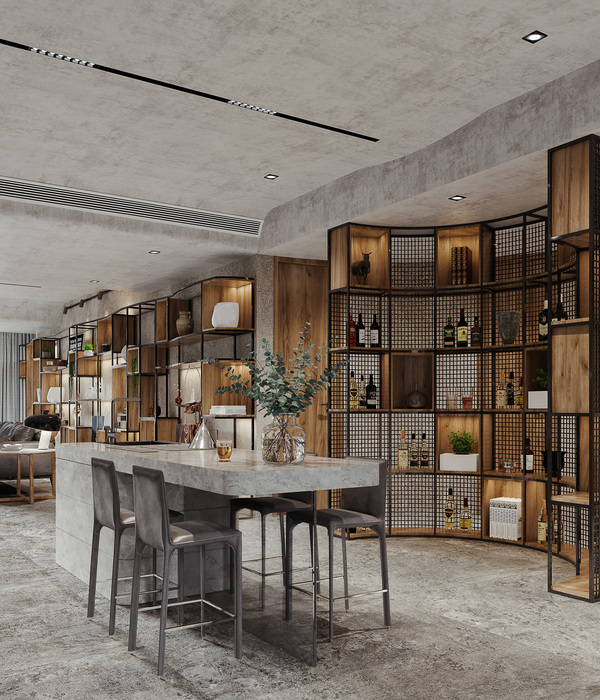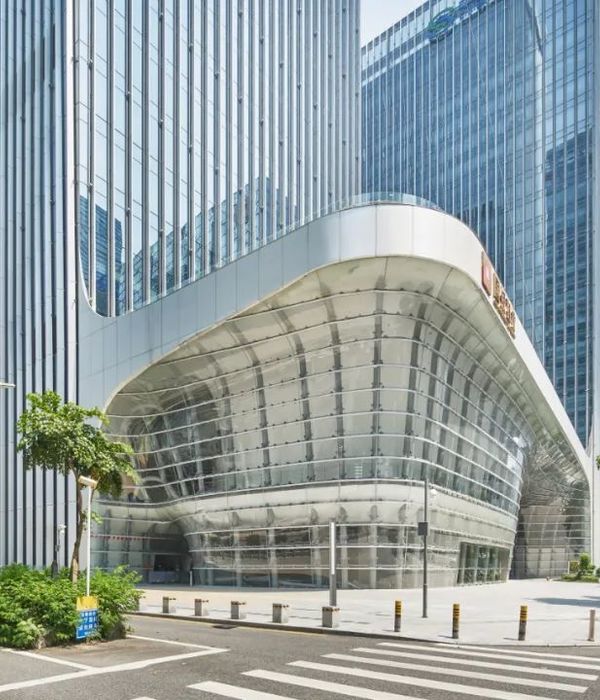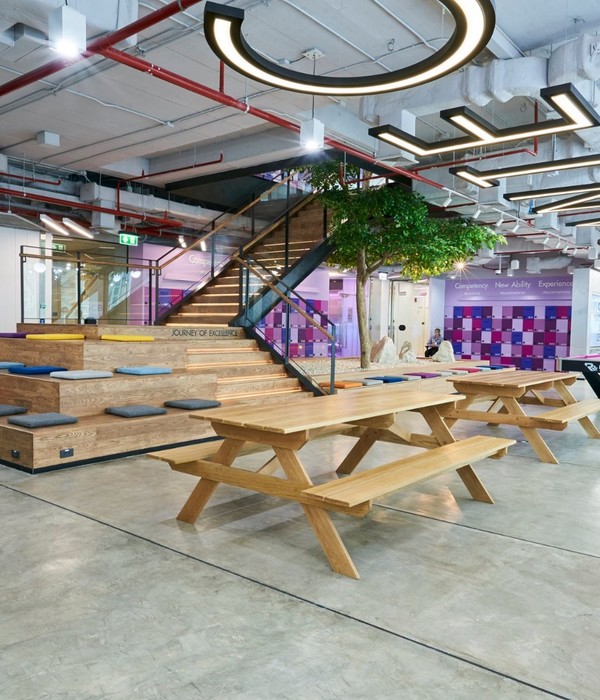- 项目名称:Kathleen Andrews运输车库
- 建筑外观:带有垂直波纹,宽度不一的高保温不锈钢板组成
- 建筑内部:纯粹有力,只有一种颜色
- 入口空间:宽敞的低层集合区域
- 楼梯:富有雕塑感的楼梯
- 天窗:自然光引入室内
- 停车场:公交车停放空间,维护区,洗车区
位于埃德蒙顿的Kathleen Andrews运输车库(KATG)是一个城市公交维护存储设施,此项目的设计为此类经常被忽视的建筑类型建立了新的标准。KATG的设计将技术需求与简洁严谨的建筑结合在一起,在满足功能性的同时,体现了建筑在一座不断成长的、公平、可持续、高适应性城市中的重要作用。设计通过优雅的外形、历史保护和公共艺术,连接高效与高可持续性,丰富了项目中工作人员的生活,同时也使其所服务的更广阔的社区获益。
Edmonton’s Kathleen Andrews Transit Garage (KATG) is a municipal bus maintenance and storage facility designed to set new standards for an often-overlooked building type. Reconciling demanding technical requirements with simple and rigorous architecture, KATG elevates a conventionally utilitarian building and honours its important role within a growing, equitable, sustainable, and resilient contemporary city. Functional efficiency and high sustainability are matched by formal refinement, historic preservation, and public art, enriching both the lives of the people who work there and the wider community it serves.
▼建筑外观,external view of the building
KATG项目的名字取自埃德蒙顿第一位女性公交车司机,可以容纳300两巴士,35个维护处,3个底盘清洗区,4个加油点以及洗车区。地下层为员工使用的停车场,从夏季的35度到冬季的零下40度,全年温度的变化幅度极大。繁忙的运输中心需要支持800名工人在此工作,包括公交车司机、维护工、管理员和运输安保人员。在为工人和机械创造适宜环境的同时,设计还要回应城市基础设施的尺度。
建筑基地面积超过4万平米,位于加拿大横贯公路和Fort大道的交口处,与CP铁轨平行。1936年,基地上是Canada Packers的屠宰场、畜栏和肉类加工场。这座工厂由著名建筑师和教育家Eric Arthur设计,是加拿大现代主义功能建筑的最佳代表。工厂于1980年代被拆除,只留下了一座50米高的烟囱。KATG保留了该建筑遗迹,通过生态绿化、微气候介入、生态湿地和大量植树等手段,修复了这片工业棕地。不仅如此,深思熟虑的景观设计还使用了填满Albertan河石的金属筐和橡胶颗粒铺地,让建筑与景观无缝融合在一起,同时突显了记忆中的地基和烟囱等曾经存在过的设施。
▼总平面图,基地环境,site plan, surrounding environment
▼功能分区,program zoning
Named after Edmonton’s first female bus driver, KATG houses 300 buses, 35 maintenance bays with three undercarriage wash bays, four refuel bays and exterior wash bays. One level of employee parking is provided below grade — important in a locale whose temperatures can vary considerably from 35°C at the peak of summer to -40°C in winter. The busy hub supports 800 workers including bus drivers, maintenance, administration, and transit security staff with the intimate conditions of the workplace, whether human or mechanical, as well as the scale of urban infrastructure.
The building sits on a 10-acre site at the intersection of the Yellowhead Trail (the Trans-Canada Highway) and Fort Road which aligns with the CP Rail tracks. In 1936 the site was occupied by the Canada Packers’ abattoirs, stockyards and meat processing plant. Designed by famed architect and educator, Eric Arthur, the Canada Packer’s factory was a prime example of functional Canadian modernism until it was demolished in the 1980s apart from its 50-metre-tall smokestack. KATG restores this legacy by conserving the smokestack and remediating the brownfield site through ecological greening, micro-climatic thresholds, bioswales and dense tree planting. Moreover, thoughtful landscaping including gabion baskets filled with Albertan river stones and granulated rubber tire ground cover are appropriate materials to seamlessly integrate architecture and landscape, while also highlighting the foundations and the smokestack in memory of what existed there before.
▼景观与建筑的整合
integration of the building and the landscape
KATG是一栋坐落在宽阔基地上的巨大建筑,面积达50000平米。连续的立面由带有垂直波纹、宽度不一的高保温不锈钢板组成,打碎了项目盒子一般的外观。建筑沿Fort大道的部分设置了5个屋顶光井,围合楼梯和机械系统,赋予建筑城市的尺度。光井上方覆盖柏林艺术家Thorsten Goldberg创作的雕塑,参考了同纬度山区的地形,反衬了埃德蒙顿作为世界上地势最平缓地区之一的景观特征。不锈钢雕塑与建筑表皮结合,为统一的建筑增添对比,激发人们的好奇心和愉快感,无论他们是步行还是驱车经过。
At 50,000 m2 KATG is a big building on a big site. Its box-like form is broken down by its continuous surface, wrapped in highly insulated stainless-steel panels with vertical corrugations and variegated widths. Furthermore, along Fort Road, five rooftop light wells enclosing stairs and mechanical systems give the building scale. These are capped by sculptures by Berlin artist Thorsten Goldberg referencing the topography of mountainous regions around the world that are at the same latitude as Edmonton — ironically one of the world’s flattest landscapes. The stainless-steel sculptures synthesize with the building’s surface, adding contrast to the uniformity of the architecture, stimulating curiosity and delight whether encountered by car or by foot.
▼外观,光井上的雕塑和不锈钢板立面,external view, sculptures on the light well and stainless steel surface
▼立面和雕塑近景
closer view to the building surface and the sculpture
▼不锈钢板细部
details of the stainless steel panels
建筑内部只有一种颜色,纯粹有力。员工通过宽敞的低层集合区域进入,通过一座富有雕塑感的楼梯上到被天光照亮的中庭。设计优化了巴士操作、存储和维护的流程,促进了蓝领和白领员工之间的交接与互换,利用建筑体现了一种近乎于政治形式的共治。与传统车库不同,公交站的室内为明亮的白色,有利于健康和清洁。大胆而精确的建筑在各个尺度上为埃德蒙顿的运输工人提供了尊严与尊重,其本身也引人骄傲。作为新的公共地标,建筑还为市民带来了场所自豪感,并且呼吁为此类对于城市共享体验如此重要的建筑建立更加严格而精确的设计标准。
Inside, the building is powerfully pure and monochromatic. Employees enter through a generous lower-level congregating area, and up to a day-lit central atrium via a sculptural stair. The facility is designed to optimize the maneuvering, storage, and maintenance of the bus fleet and to promote overlap and exchange between blue- and white-collar personnel, in an almost political gesture of collegiality represented through architecture. In contrast to the conventional garage, the bus station interiors are bright white, helping to facilitate both wellness and cleanliness. Such bold and precise architecture, executed at all scales, offers dignity and respect to Edmonton’s transit employees and pride in its fleet. As a new civic landmark, the building also provides pride of place for citizens and argues for more ambitious and exacting design standards for a building type that is so important to our shared urban experience.
▼入口空间,entrance space
▼富有雕塑感的楼梯
sculptural staircase
▼天窗将自然光引入室内,skylights introducing natural light into the space
▼更衣室,locker room
▼停车场,parking
运输仓库鲜少引起设计师和公众的注意,尽管它们的功能对于绝大多数社区来说至关重要。KATG试图赞扬这些服务,创造一个新的公共地标,进而彰显埃德蒙顿作为一座进步城市的声誉。
Transit depots rarely attract attention from either designers or the public, despite their functions being critical to the life of most communities. KATG attempts to celebrate these services with a new civic landmark, and further Edmonton’s reputation as a progressive city.
▼公交车停放空间,bus storage
▼维护区,maintenance bay
▼洗车区,bus washing bay
▼平面图,plan
▼剖面图,section
Name of Project: Kathleen Andrews Transit Garage Client: City of Edmonton
Location: Edmonton, Alberta
Architecture: gh3*
Structural Engineer: Morrison Hershfield Mechanical Engineer: Morrison Hershfield Electrical Engineer: Morrison Hershfield Civil Engineer: Morrison Hershfield LEED Engineer: Morrison Hershfield Heritage Consultant: David Murray Contractor: Graham Construction Landscape Architect: gh3*
Interiors: gh3*
Building Area: 50,000 m2
Completion Date: March 2021
Photo Credit: gh3*
{{item.text_origin}}

